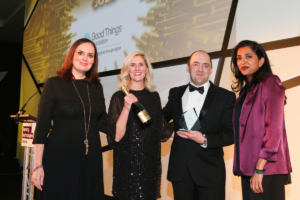Blended learning: what is it, and what are its advantages?
Our Curriculum Development Manager, Laura Faulkner, explains what blended learning is and its advantages.
The issue
The learning team at Good Things Foundation are award-winning at creating ‘Blended Learning’. We know this because we won a prestigious award for it at ‘The Learning Technologies Awards’ in London (Nov 2018).

On a daily basis we work to support a network of thousands of online centres around the UK in delivering blended learning to people wanting to improve their digital skills. We know that staff and volunteers in our centres are skilled at blended learning and we are able boast impressive statistics about the success of this great work.
All sounds great.
Yet last month, there was a surprise in store for the learning team whilst delivering workshops with our network staff. When we asked people to tell us about their blended learning sessions, we were often met with silence and blank faces! Strangely, when we asked people to describe sessions with learners, they very often gave us brilliant examples of blended learning. We soon realised that the term ‘blended learning’ might need a bit of explanation.
The definition
Most people probably understand the word ‘blend’. It means to mix two or more things together. This is also the concept in ‘blended learning’. It means to mix together different activities during a learning session. For our network, this often means using electronic and online media alongside more traditional discussion groups and worksheet tasks.
So do you already use blended learning without even knowing it?
Chances are you do.
The learning team at Good Things Foundation believe that using different activities during a session (blended learning as we call it) is a great way to engage learners and create valuable learning experiences. The theory and research agrees with us, stating that it does lead to good tutor practise and great learner outcomes.
So what kinds of activities can you blend together in your sessions?
The list could be endless but if you want to get technical about it, there are five types of learning that often happen during sessions. If you are using two or more of them during a session, then you are using a blended learning approach.
- Instructional Learning – This is where the tutor tells the learner what to do. It is a traditional ‘’chalk and talk’’ style within a session and is often associated with school experiences. The learner will often then practice the skills themselves.
- Constructivist Learning – This is when the sessions build on learners’ prior knowledge and experience to ‘construct’ new ideas. It helps people relate new information to their life experiences.
- Social Constructivist Learning – This is when people learn by interacting and collaborating with others in groups. This could be through discussion of how they have tackled problems in the past and comparing to other peoples’ approaches.
- Problem Based Learning – This is when sessions use real-world scenarios and allow people to apply their knowledge to realistic situations. It could involve the use of case studies on digital devices.
- Self Discovery Learning – This is where the learner is encouraged to discover facts and make links themselves. In sessions, the tutor might ask questions for people to research or demonstrate how to research information before allowing learners to do it for themselves.
The advantages
If you already do blended learning, please share with us the advantages you feel it brings to your learners’ experience. Here are some of the advantages the style of delivery is thought to bring:
- Flexibility – Bringing different types and styles of activity to sessions means no two sessions have to be the same and can be changed to suit learners taking part.
- Effectiveness – Research supports the idea that blended learning results in learners becoming confident in their own learning. This often leads to people continuing to learn outside of the classroom. It empowers them to know how to do this online.
- Tutor Time – Using digital tools along with other teaching methods can give tutors more time to work with individual people. It can also make it easy for tutors to collect the results of assessments and use them to guide learners on improving their skills.
- Engagement – The different activities provide a good pace to sessions that helps to keep people interested. It also allows use of everyday technology in learning such as smartphone apps.
- Differentiation – The approach means that not all learners have to do the same activities. Tutors can help the learner choose an activity that suits them and that will provide the right level of challenge for that person.
Support to achieve blended learning
If you like the idea of creating more blended learning at your centre, we already have some ideas available for you to view and choose from. Go to the tutor support materials on Learn My Way. There, you will find session plans with blended learning ideas.
Get in touch
If you are using Learn My Way as part of your blended learning offer, we would love to hear how you are doing it. Please share any tips, advice for other centres and ideas with us.
Email us at learning@goodthingsfoundation.org with your thoughts and suggestions.

Laura Faulkner
Curriculum Development Manager
Laura reviews and grows our learning offer to keep it up to date, relevant for learners and ensure it is accessible to our users. Alongside this, her role also includes the creation of materials that support our tutors in their day to day work in our communities.
